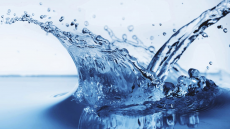

Water, so simple yet rather complex. It makes up roughly 80% of your cells contents and has a range of functions. Water is a reactant, habitat, transporter, solvent and helps with temperature control.
What is the structure of water?
The structure of water relates to its function, so it is very important to understand it. One molecule of water comprises of one oxygen atom covalently bonded to two hydrogen atoms. In this covalent bond, electrons are shared. The oxygen atom has 6 electrons in its outer shell whilst the hydrogen atoms have 1. The oxygen atom attracts the electrons from hydrogen towards itself giving the oxygen atom a slight negative charge (known as delta negative, written as δ-). Hydrogen therefore has a slight positive charge (δ+). The unshared electrons on the oxygen atom is what gives it its slight negative charge. As there is a separation of charge across the molecule, this makes water polar. The slightly negative oxygen atom attracts the slightly positively charge hydrogen atoms of other molecules creating a hydrogen bond.
Why is water a reactant?
It participates in lots of chemical reactions, for example hydrolysis reactions where water is used to split a molecule.
How does water help with temperature control?
Because water has a high specific heat capacity and a high latent heat of evaporation. Specific heat capacity is the amount of energy needed to raise the temperature of 1 gram of substance by 1℃. Hydrogen bonds can absorb a lot of energy, this is why it takes a lot of energy to raise the temperature of water. Latent heat of evaporation is the energy needed to break hydrogen bonds, as water has a high latent heat, it requires a lot of energy to evaporate water. This is useful in organisms for various reasons, one being, when we sweat. A lot of energy is needed to evaporate the sweat, thus once the water is evaporated, we cool down because we have used that energy to do so.
How is water a habitat?
Simple, many plants and animals live in water. The properties of water means that temperature can be controlled and as water is a solvent, useful nutrients can be dissolved and used by organisms. Water is an anomaly. Solid water (ice) is less dense than liquid, hence why ice floats. This is because when water freezes the hydrogen bonds are held further apart in a lattice structure. Thus a layer of ice on top of water provides insulation, this is useful for organisms living in cold water as there is insulation. Furthermore, water temperature is relatively stable making it ideal to live in as chemical reactions inside an organism can continue to take place.
How is water a transporter?
The fact that water is a liquid and a solvent means that substances can easily move through or alongside the movement of water to be transported to places. For example, glucose and oxygen in the blood. Waters polarity makes it cohesive. Cohesion is the attraction between molecules, cohesive water molecules means that substances inside the water can be transported.
Why is water a solvent?
You may see the term ‘soluble in water’ and that means that the substance can be dissolved when surrounded by water. Most biological reactions take place inside solution but some substances are water insoluble. The charges in water allow it to surround charged ions and break ionic compounds apart.
Image credits:
https://www.prominent.co.uk/media/Applications/app-water-treatment-and-disinfection_Header_1.jpg

0 Comment:
Be the first one to comment on this article.